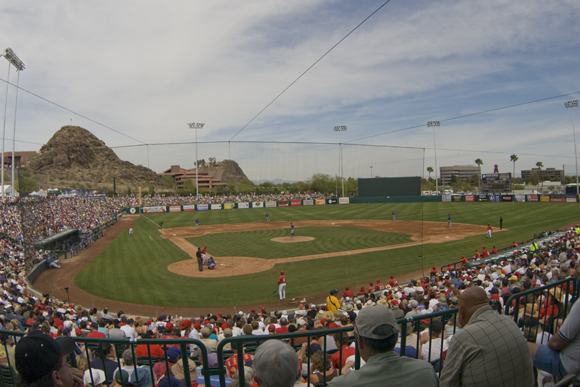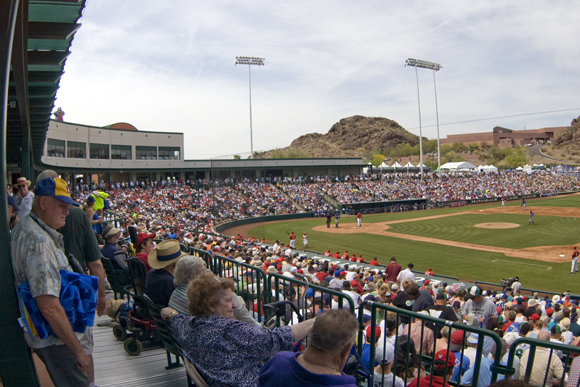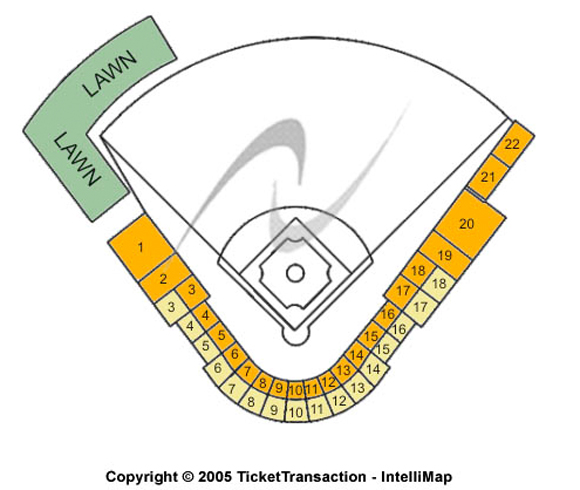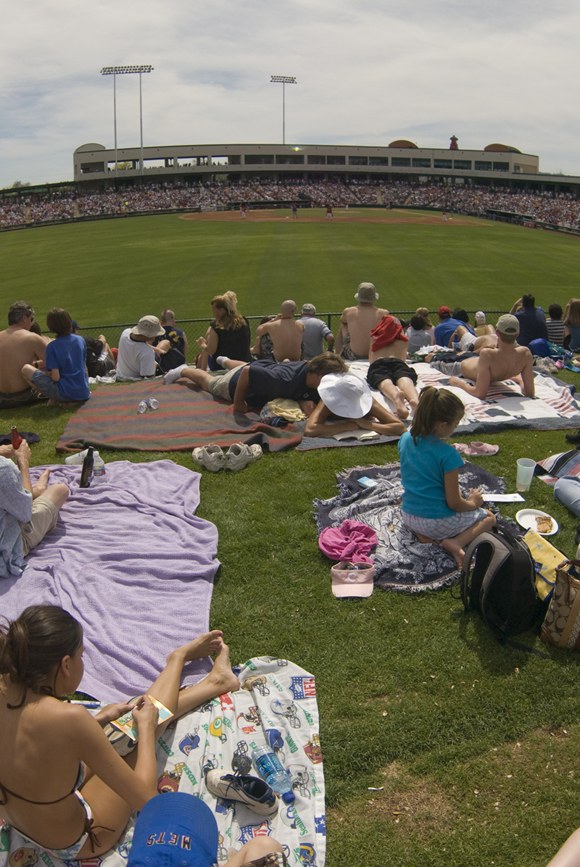It is the most scenic ballpark in the Cactus League, bar none. With buttes beyond the left-field fence, a striking Spanish-style exterior and a relatively remote location that paradoxically offers easy freeway access, Tempe Diablo Stadium is a gem, a must-visit for anyone hitting Phoenix in March.

FAST FACTS
Year Opened: 1968; renovated several times since
Capacity: 9,558 (7,285 seats, plus berm seating)
Dimensions: 340L, 388LC, 405C, 308RC, 340R
Playing Surface: Grass
Home Dugout: First-base line
Address/Directions: 2200 West Alameda Dr., Tempe, AZ 85282, Take Broadway Street exit off I-10 (coming from either direction); travel west on Broadway to 48th Street; turn left; Tempe Diablo Stadium is 1/2 mile on the left. Enter ballpark by turning left on Alameda.
Written By: Kevin Reichard
The two best things about the ballpark are its location and its layout. It’s easy to get to — get on I-10 south, take the Broadway Street exit, and follow the signs — and there’s plenty of cheap adjacent parking. Tempe is within 10 minutes of the Phoenix airport, which makes it easy to hop into the car and hit a game right after arrival. And, of course, Phoenix is an easy drive from Los Angeles, which allows passionate Angels fans the chance to see their team in action at a great, intimate facility. And those fans have responses. A few years ago it was easy to snare an Angels spring-training ticket, but these days the Halos are one of the hottest spring-training tickets in the Cactus League. Plan ahead; the days of walking up and snaring a good ticket 30 minutes before game time are gone.
The ballpark itself is very fan-friendly. Renovations in 1993 made the place a much more accessible venue, adding a concourse level above the bowl housing a wide variety of concession offerings, while a second set of renovations in 2006 expanded the training facility and provided a new entrance. Throw in easy accessibility to practice fields (located on the other side of the parking lot from the ballpark) and you have a great spring-training experience.
The original Diablo Stadium was built in 1968, but it was expanded in 1993 under the supervision of Populous. The original playing field, seating bowl and visitors’ clubhouse were incorporated into the new facility, which added a new clubhouse, enclosed batting tunnels, and more.
In addition, the renovation added five concession stands, a concourse-level plaza area, an observation deck, and a picnic area down the third-base line. It’s worth getting to the park early to snare one of these picnic tables, as they’re fairly close to the action; their usability is somewhat limited by the fact that the Angels don’t allow any outside food at all in the ballpark.
The latest round of renovations added more training fields to the mix (six full fields in total), practice facilities and a minor-league clubhouse, as well as a new entrance to the ballpark. Previously the Angels had practiced at an offsite facility, but the latest expansion allows all the major- and minor-leaguers to train at the same location.
The layout of Tempe Diablo Stadium is standard, with most of the seating occurring in the grandstand, which are roughly half armchair seats and half bleachers. There is also lawn seating in left and center field. The best seats are the box seats down the first-base line: You’re definitely in a sun field, but the view of the buttes beyond the ballpark is spectacular. There’s a minimum of foul territory, so you’re never too far from the action — which includes rubbing elbows with pitchers warming up in both bullpens down each line. 
ADV.: Buy your Los Angeles Angels of Anaheim tickets here!
Not every seat is created equal, of course. In general, you’ll want to sit in the last four rows of the grandstand behind home plate or on the first-base side if you want to avoid the sun; a canopy covers concessions, not seats. (Try the back of section 12 for a good, shaded seat.) Speaking of avoidance, don’t sit in sections 23 or 24. Better choices are sections 21 and 22 — which feature raised bleachers — while sections 1-4 and 18-20 feature bleacher seating as well.
One underrated area of seating: the berm, which runs down the left-field line and wraps around the foul pole into left field. As a bonus, the berm seating overlooks the bullpens, and there’s generally a lot of room out there.
As if you can’t tell, we adore a spring game at Tempe Diablo Stadium. The Angels have kicked up their level of fan commitment and the fans have responded, making Tempe Diablo Stadium one of the great hot spots in spring training.
Concessions
The one mandatory food item at Tempe Diablo Stadium is a mesquite-grilled hot dog. You can smell those pups from the parking lot, so beware of heading to the ballpark on an empty stomach. Diablo Dogs are actually brats topped with jalapenos.
Then again, maybe you should go to the ballpark with an empty stomach, because there are a wide variety of foodstuffs on the menu, ranging from Mexican specialties and pad Thai to root-beer floats and fresh-squeezed lemonade. You can even find an espresso stand on the concourse.
Most of the beer stands feature corporate swill, like Budweiser. Near Section 13 there’s a stand with a wider variety of microbrews, including Fat Tire, Fosters, Tecate and Widmer.
Autographs
If you get to the ballpark early enough you should hang out in the parking lot: Players practice in the adjoining practice field in the morning and must cut across the parking lot while heading to the clubhouse. The Angels rope off a walkway for players, but you can wait alongside it and snare some autographs.
Inside the park, plant yourself next to sections 21 and 22. These sections are located next to the tunnel leading to the clubhouse, so players and coaches have no choice but to walk past fans here. Also, players are known to hang around the bullpen before games, so you should head down there and snag an autograph. If you’re seeking the autograph of a visiting player, head down the right-field line after the game and catch the attention of players heading for the team bus. The parking lot to the east of the ballpark is secured, so you can’t seek autographs next to the bus or the right-field gate.
Parking
There are two main parking lots on the east and west sides of the ballpark, but in general the west lot is reserved for players, the front office, and VIPs. Unless you come to the ballpark really early, you’ll be shuttled down to the east lot or other lots of Ajo Way. Some businesses also sell parking, but don’t be gouged: Generally the parking offered by the Angels is cheaper. There is also limited street parking in the area, but be warned: The area is crawling with cops, and you will be towed if you’re parked illegally.
Because the Angels have grown into a hot Cactus League ticket, it’s in your best interest to arrive at the ballpark early. During our last visit we arrived at the ballpark an hour early and we still were presented with a huge traffic jam on Ajo Way.
Angels Spring-Training History
The major-league Los Angeles Angels began playing in 1961 under the ownership of Gene Autry. The team’s first spring-training home was Palm Springs, where their home was the Polo Grounds (later renamed Angels Stadium).
In 1966 the Angels partially shifted spring training in Holtville, Cal., and 10 days to two weeks at the four-diamond complex from 1966 through 1979 (splitting time with Palm Springs), before returning on a full-time basis to Palm Springs in 1980. The Angels then reverted back to a split schedule in 1982 and 1983, dividing spring headquarters between Casa Grande, Arizona, and Palm Springs.
In 1992, the Angels spring training shifted full-time to Tempe Diablo Stadium.





